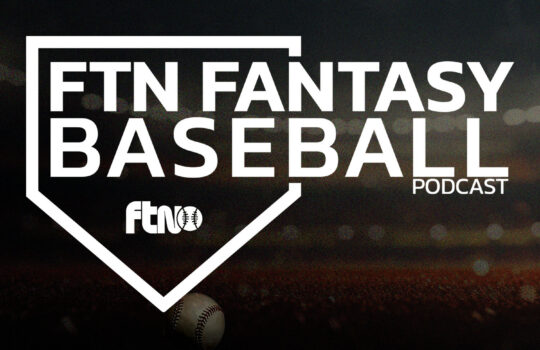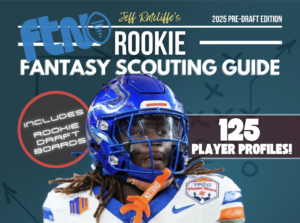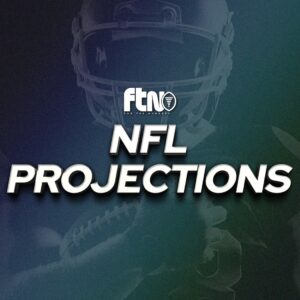
The NFL season is just around the corner, and with it comes an unmatched excitement not only for the sport America loves the most, but for DFS sweats that hit the hardest. Year after year, we convince ourselves that this year will be our best from an NFL DFS perspective. The only issue is that we can’t all be right. Some of us will have great seasons, some of us will have okay seasons, and some of us will hemorrhage money like Chandler playing “Cups”.
To maximize our chances of being a part of the first group, we want to formulate an overall plan of attack. This plan should cover everything from bankroll management and contest selection to identifying the type of chalk we want to consistently fade, as well as everything in between. For example, TwoGun wrote in Week 13 of last season about his systemic practice of fading chalk that people have become overconfident in late in the season.
Before we dive deeper into the more granular aspects of lineup construction, like TwoGun’s approach to chalk late in season, stacking principles, and my favorite concept of all – correlated leverage, let’s zoom out to the macro level. Specifically, we’ll begin with bankroll management, contest selection and an understanding of what we want to accomplish with each lineup.
Bankroll Management
It’s boring, and even annoying, to put a large focus on bankroll management, but it’s necessary. Several years ago, there was a promotion and some giant rake-free contests that led me to play about 5x what I would otherwise have played in Week 1. I lost it all and decided to play a similar amount in Week 2 because there was another giant rake-free contest. I lost it all again. Then in Week 3, I made the wise decision to dial back down to my usual bankroll allocation and got a single-entry takedown which took me all the way to …breaking even through three weeks. When you stretch your bankroll too much, you diminish the importance of your wins in the likely scenario that they come after your bankroll has been rapidly depleted. Find what works for you, but here are some rules I like to follow:
- 3% of my bankroll for every main slate
- 1% of my bankroll for secondary slates (like early slates, primetime slates and island game showdowns)
- Flexibility around those percentages to ensure I’m in the best contests for my strategy
Targeting 99th percentile outcomes
DraftKings has a number of common contest-structures, but my favorite is their 277-person single entry that pays out 20% to first. In this contest, 38.2% of the entire prize pool is paid out to the top 1% of finishers (calculated as 1st + 2nd + .77 * 3rd). While not every contest is structured in this exact way, the theme is true across all GPP tournaments – the money is at the top. Consequently, my goal with every lineup is to maximize my chances of a top 1% finish, even if it decreases my chances of cashing at all. In other words, I’m shooting for the single-entry stars with each lineup.
Contest Selection
Naturally, our contest selection should mesh with both our bankroll management and our goal for each lineup. For me, that means finding contests that will most greatly reward a 99th-percentile outcome. As some of you may recall from my Discord office hours, I want single-entry contests that are top-heavy overall but flat at the top (10th should make ~10% what first makes), with something like 200-300 people in it.
A quick side note here. Avoid playing single bullets in contests where sharks will have multiple lineups as much as possible. I won’t bore you with the math here, but you’re putting yourself in a -EV situation because sharks will be able to inversely correlate their lineups, giving them a probabilistic advantage. This is why I stick to single-entry contests for the majority of my investment.
Ultimately, I’m trying to maximize my EV by finding top-heavy single-entry contests that fit my strategy and then attempting to maximize my probability of realizing that EV by keeping the size of the contests under control. Even if you have a gigantic edge, the chance of taking down a contest with several thousand or more people is so low that you could easily finish the NFL season in the red with perfect process elsewhere.
Let’s Get Granular
There are two concepts I lean on most heavily to shoot myself up to the tops of leaderboards – correlation through game-stacking and correlated leverage.
Stacking
To stack is to use multiple players from the same team and game. My preference is a QB and two of his receiving options from one team, with a receiving option from the opponent as well. Why do we do this? Correlation. The probability of your lineup as a whole hitting a ceiling outcome increases dramatically if the players’ ceilings within your lineup are positively correlated. Like MLB, correlation is especially powerful in NFL DFS because of the variety of ways it manifests itself. You should not build a single NFL DFS lineup without some sort of stacking involved.
There are numerous ways to think about correlation, with the most obvious being a TD for your WR is also a TD for your QB if you stack them together. While this is true, it doesn’t get to the heart of why we care – which is correlated ceilings. Instead, I like to think about it from a conditional probability perspective. If I assume one thing to be true, how does the probability of the other thing change? This isn’t the most straightforward concept, so let’s use an example.
DeSean Jackson was one of my favorite GPP plays last year, and I used him over and over. In 18 weeks, he was a magical play only twice, but 2/18 is a hell of a lot higher than 1%!
Whether on the Rams of Raiders, the theory went like this:
A QB who lacks rushing upside (Matthew Stafford and Derek Carr) is more dependent than most on home-run type big plays in order to have a true ceiling game. Consequently, the ceilings for DeSean Jackson and his QB were extremely correlated even if their overall performances weren’t overly correlated. Jackson was part of an optimal double stack against the Buccaneers and then again against the Cowboys on Thanksgiving:
There’s a second way that ceilings are correlated within a stack, and it also applies to the bring-back. A player’s ceiling dramatically increases in the perfect game environment. A high-paced shootout where each team is pushing the tempo and aggressively throwing the ball downfield is good for everyone involved. If you’re game-stacking, only one game needs to turn into a shootout for nearly half of your lineup to have access to their true ceilings.
Correlated Leverage
From my weekly Stacks & Correlated Leverage article:
“GPPs are a game of probability. We can think of the chance of our lineup “hitting” as the chance of all of our individual plays hitting. This is why we stack – by adding correlation, we increase the probability of a group of players hitting at the same time.
A great analogy is to think of our lineups as parlays, where adding correlation can decrease the “legs” of a parlay. In other words, we stack to decrease the number of things we need to be right about in order for the lineup to hit. However, I believe it’s a mistake to think of the parlay as confined to our own lineup – we also need to be right about the chalk that we fade. This is where correlated leverage comes into play.
Correlated leverage exists when we pivot away from fragile chalk to a contrarian option who is inversely correlated with the chalky option.
Let’s use an example from Week 2 of [the 2020 season] to drive home the concept. In Week 2, Davante Adams was nearly 50% owned in single entries, while his teammate, Aaron Jones, was just 10% owned. Playing Jones over Adams was a correlated leverage opportunity because a ceiling game from Jones would decrease the chance of a ceiling game and increase the chance of a floor game from Adams. If the two were independent of one another, you would need to be right about Jones hitting AND Adams not – two things. Their inverse correlation meant being right about Jones – one thing – would all but guarantee you were right about fading Adams, as well. Just like stacking, correlated leverage is therefore a way that we can decrease the number of things we need to be right about for our lineup to hit.”
If the description of correlated leverage reminds you of the conditional probability discussion in regards to DeSean Jackson and correlated ceilings, it should! Similarly, correlated leverage decreasing the number of things we need to be right about is a remarkably similar concept to that of game-stacking in order to decrease the number of games we need to fall into shootouts to benefit as many of our players as possible.
For correlated leverage to be most effective, we want the following conditions to be satisfied:
- A fragile chalk option
- A contrarian option inversely correlated with the chalk option
- Minimal competition around the contrarian option’s price range
The first two are obvious, but the third one is nearly as important. Recall the point about also needing to be right about who we fade. In TwoGun’s Week 13 article I linked above, he discussed an abundance of underpriced RBs. A correlated leverage play in that range of RBs wouldn’t have been ideal because we would have needed him to hit AND for all of the other chalky, underpriced RBs to underwhelm in order to get the full benefit. Thus, it would have been a lower-probability play than an otherwise equally good correlated leverage play in a pricing tier with less competition.
It’s Okay to be Wrong
Lastly, understand that throughout the NFL season, you will be wrong… a lot. Good process will often end in bad results, and there’s nothing we can do about that. In fact, you’ll be wrong about certain players because you focused too much on certain stats and not enough on others. These mistakes are okay – even inevitable, so we shouldn’t sweat them. Instead, we should focus our attention on avoiding mistakes at the macro level, be it bankroll management, contest selection or roster construction mistakes. If every lineup you build contains a game stack and one correlated leverage play, and you’re both consistent and disciplined with your contest selection, I like your chances of coming out on top at the end of the all-too-short NFL season.












































 New York Jets
New York Jets  New England Patriots
New England Patriots  Miami Dolphins
Miami Dolphins  Buffalo Bills
Buffalo Bills  Pittsburgh Steelers
Pittsburgh Steelers  Cleveland Browns
Cleveland Browns  Cincinnati Bengals
Cincinnati Bengals  Baltimore Ravens
Baltimore Ravens  Tennessee Titans
Tennessee Titans  Jacksonville Jaguars
Jacksonville Jaguars  Indianapolis Colts
Indianapolis Colts  Houston Texans
Houston Texans  Las Vegas Raiders
Las Vegas Raiders  Los Angeles Chargers
Los Angeles Chargers  Kansas City Chiefs
Kansas City Chiefs  Denver Broncos
Denver Broncos  Washington Commanders
Washington Commanders  Philadelphia Eagles
Philadelphia Eagles  New York Giants
New York Giants  Dallas Cowboys
Dallas Cowboys  Minnesota Vikings
Minnesota Vikings  Green Bay Packers
Green Bay Packers  Detroit Lions
Detroit Lions  Chicago Bears
Chicago Bears  Tampa Bay Buccaneers
Tampa Bay Buccaneers  New Orleans Saints
New Orleans Saints  Carolina Panthers
Carolina Panthers  Atlanta Falcons
Atlanta Falcons  San Francisco 49ers
San Francisco 49ers  Seattle Seahawks
Seattle Seahawks  Los Angeles Rams
Los Angeles Rams  Arizona Cardinals
Arizona Cardinals 








 Boston Celtics
Boston Celtics  Brooklyn Nets
Brooklyn Nets  Philadelphia 76ers
Philadelphia 76ers  New York Knicks
New York Knicks  Toronto Raptors
Toronto Raptors  Chicago Bulls
Chicago Bulls  Detroit Pistons
Detroit Pistons  Milwaukee Bucks
Milwaukee Bucks  Cleveland Cavaliers
Cleveland Cavaliers  Indiana Pacers
Indiana Pacers  Orlando Magic
Orlando Magic  Atlanta Hawks
Atlanta Hawks  Charlotte Hornets
Charlotte Hornets  Miami Heat
Miami Heat  Washington Wizards
Washington Wizards  Denver Nuggets
Denver Nuggets  Minnesota Timberwolves
Minnesota Timberwolves  Oklahoma City Thunder
Oklahoma City Thunder  Portland Trail Blazers
Portland Trail Blazers  Utah Jazz
Utah Jazz  LA Clippers
LA Clippers  Golden State Warriors
Golden State Warriors  Los Angeles Lakers
Los Angeles Lakers  Phoenix Suns
Phoenix Suns  Sacramento Kings
Sacramento Kings  Dallas Mavericks
Dallas Mavericks  Houston Rockets
Houston Rockets  Memphis Grizzlies
Memphis Grizzlies  New Orleans Pelicans
New Orleans Pelicans  San Antonio Spurs
San Antonio Spurs 










